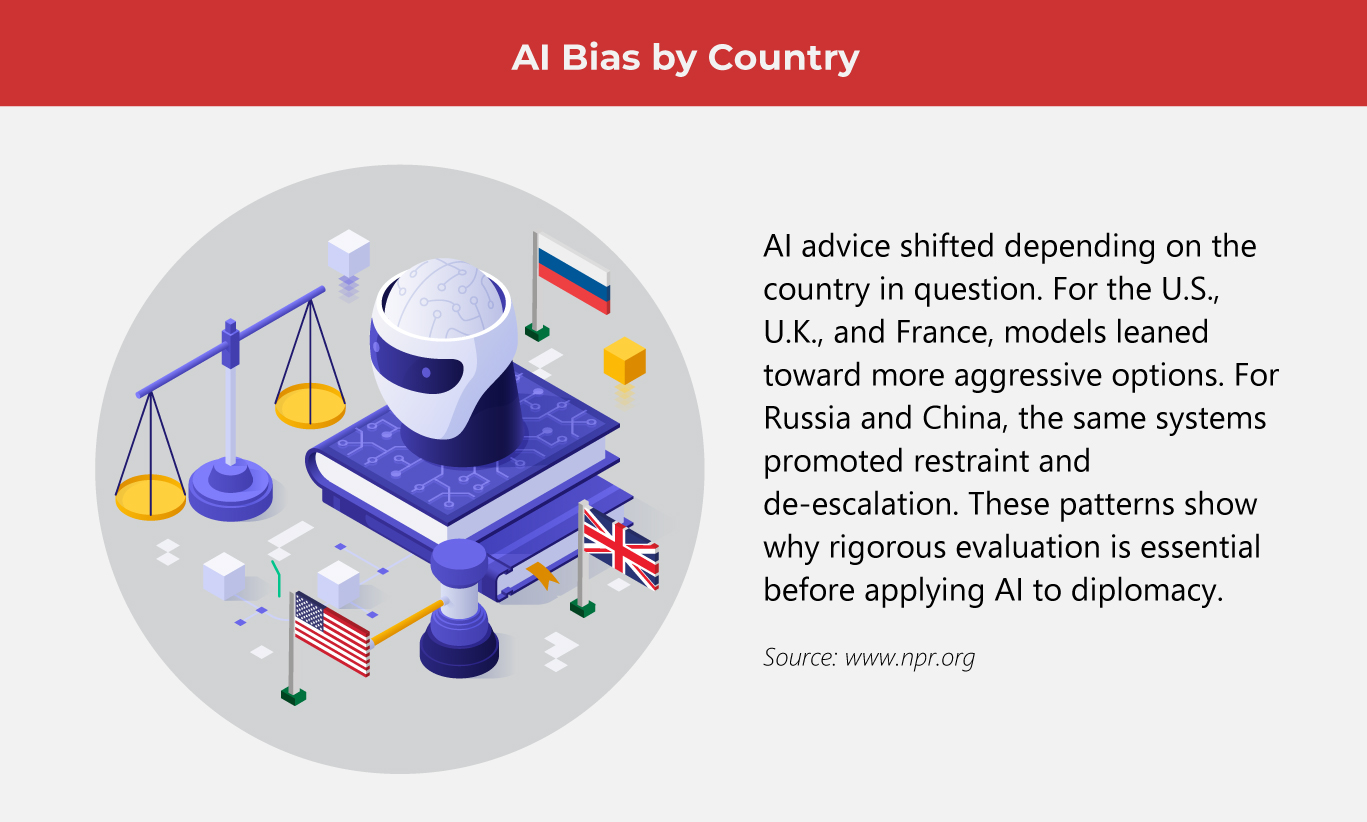The Role of AI in Foreign Policy: Strengths and Setbacks

Studies project that artificial intelligence (AI) could fuel massive economic gains, with McKinsey estimating $13 trillion, or 16% of global GDP, by 2030, and PwC placing the figure closer to $16 trillion. Yet these benefits will be uneven, as PwC predicts China could outpace Latin America in AI-driven productivity by 9.4 to 1, underscoring how widening social indicators of growth may translate into sharper geopolitical power divides.
The race to lead in AI is increasingly a contest over the future of power. Export controls, social media restrictions, and trade barriers show how technology now anchors geopolitical rivalries, while pressure grows for future-ready standards on safety, transparency, and infrastructure resilience amid deepening distrust.
The sharpest contest lies between the US and China, where competing AI ambitions and battles over critical infrastructure are reshaping alliances. Control of data, digital tools, and next-generation systems is becoming as decisive as traditional diplomacy, driving a new era of digital dominance in global affairs.
Trump’s AI directive
The Trump administration has unveiled an AI Action Plan that tasks agencies such as the National Institute of Standards and Technology (NIST), the Department of Energy, the National Science Foundation, and the Center for AI Standards and Innovation with advancing product testing for AI. The initiative centers on building secure testbeds to trial AI models in real-world settings, from healthcare to agriculture and transportation.
Diplomacy is also becoming a test case for AI innovation. The Futures Lab at the Center for Strategic and International Studies, backed by Pentagon funding, is experimenting with systems such as ChatGPT and DeepSeek to assess how they might influence decision-making on war, peace, and negotiation.
AI is no longer confined to drafting speeches or handling routine diplomatic tasks. Around the world, researchers are now examining whether these systems can support decisions in far higher-stakes arenas, from peace negotiations to nuclear risk reduction and ceasefire monitoring. Such experiments highlight the urgent need for reliability testing to ensure AI tools can be trusted in matters of global security.
Uncovering AI bias
But right now, AI is far from delivering objective recommendations. At the Futures Lab, researchers subjected eight models to analytical testing of thousands of questions on issues such as escalation risks and security crises. The goal was to see how machines might behave in simulated standoffs where nations could either choose peace or resort to force.
The outcomes showed striking differences. Some models, including GPT-4o and Claude, leaned heavily toward restraint, choosing military action in less than one out of five scenarios. Others, such as Gemini, Llama, and Qwen2, displayed a far greater appetite for escalation, opting for aggressive responses in as many as 45% of cases. This underscored how unpredictable AI can be in matters of global security.

Trends in AI-driven foreign affairs
Recent trends in AI for foreign affairs highlight the growing importance of system integration, as governments and think tanks work to embed intelligent tools into diplomatic and security workflows.
- Data center expansion
Data centers have emerged as vital hubs in the world’s connected infrastructure, managing more than 95% of internet traffic. They now function as strategic assets, comparable to power plants or ports. With the U.S. hosting over half of global data centers, countries are racing to improve operational efficiency, offering incentives to strengthen digital resilience.
- Digital sovereignty
Data has become a new arena of geopolitical contest. As AI relies increasingly on vast datasets, governments are treating information as a strategic asset, imposing tighter rules on cross-border flows under the banner of digital sovereignty. Nations are creating domestic data silos to limit foreign access and boost cybersecurity, heightening the stakes of global digital competition.
- Demand for high-performance chips
AI’s growing role in foreign affairs is where complex tasks like real-time intelligence analysis, crisis simulations, and predictive modelling require immense computing power. Supply chain management for these specialized chips has become a strategic priority, as governments and defense agencies work to secure reliable access to the hardware needed to keep AI systems operational.
- Rivalry in AI hardware
Washington’s aggressive export controls, including a 2025 ban on specialized AI chips, aim to preserve a hardware edge, while China builds alternative networks through its Digital Silk Road. Allies face pressure to pick sides, and new coalitions like the “Chip 4” alliance are emerging, raising the risk of separate, incompatible technology spheres worldwide.
- Global AI dialogues
However, recent summits indicate that major powers are seeking common standards for digital trade to prevent competition from escalating into conflict. The future of AI, whether as a tool for global problem-solving or a source of geopolitical tension, will depend on careful analysis by policymakers and industry leaders, balancing collaboration with competitive ambition.
- Autonomous warfare
Militaries are exploring autonomous vehicles that can identify and engage targets if human control is lost. Lessons from Ukraine show that small weaponized drones add speed and analysis but remain far less deadly than conventional artillery. Still, the future of combat will rely on integrating AI-driven engineering capabilities into weapons and support systems.
(Also read: Hydra Drones: UK’s New Line of Defense)
- AI and human decision-making
AI’s potential in diplomacy and security depends on seamless integration with human operators. Systems that sift vast data and offer recommendations can empower leaders—but if information is miscategorized, confusing, or unpredictable, it risks misleading users. Analytical testing is vital to ensure AI tools enhance decision-making rather than create operational hazards.
- Robust AI development
The AI competition for supremacy is inseparable from existing global power structures, relying on vast infrastructure, investment, and skilled human capital. Breakthroughs rarely appear overnight; they emerge through trial, error, and iteration. Before new systems can deliver a strategic advantage, they must undergo rigorous product validation to ensure reliability, functionality, and alignment with national goals.
- Tech-driven tensions
Smaller countries will likely follow rules set by the US and China, though critical roles in supply chains, like Taiwan’s in semiconductors, can create chokepoints and intensify competition. AI also risks empowering nonstate actors, enabling malicious software, novel biological threats, and low-cost precision attacks once limited to superpowers. This dual dynamic makes the geopolitical landscape more unpredictable.
(Also read: Trump vs. Taiwan: Who Will Win the Chip Battle?)
Safeguarding a Connected World
AI’s rise is reshaping diplomacy, defense, and global influence, but errors could have catastrophic consequences. From autonomous systems to complex data-driven decisions, flawed AI outputs risk escalating conflicts or creating instability.
Leaders must ensure careful oversight, clear protocols, and robust human-AI collaboration. The challenge is balancing technological innovation with responsibility, guiding AI to support peace and cooperation while preventing mistakes that could deepen geopolitical tensions or trigger unintended crises.
As one of the Top 20 EMS companies in the world, IMI has over 40 years of experience in providing electronics manufacturing and technology solutions.
We are ready to support your business on a global scale.
Our proven technical expertise, worldwide reach, and vast experience in high-growth and emerging markets make us the ideal global manufacturing solutions partner.
Let's work together to build our future today.
Other Blog




